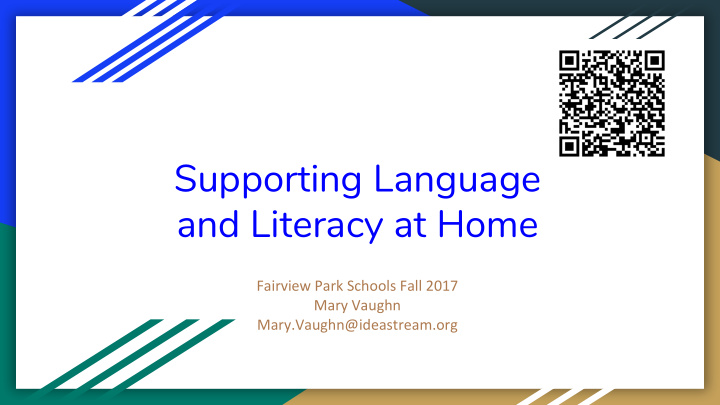



Supporting Language and Literacy at Home Fairview Park Schools Fall 2017 Mary Vaughn Mary.Vaughn@ideastream.org
Reading With Your Child
Concepts of Print Left to right ○ Top to bottom ○ Letters go together to represent words and spaces are between the words ○ Words go together to make complete thoughts ○ Print is talk written down ○ There are marks (punctuation) that we “read” and capitals ○ Page turning ○
Language and Literacy Supports
Responsibility and Jobs Making their beds- As simple as pulling up a comforter Getting out homework Packing and laying out bookbag Clearing dishes and putting them in the sink Cleaning up Toys Tying shoes
Vocabulary ● Daily Vocabulary ● Talk-When you go places use big words they might not know to describe things. ● Have your child use descriptive words to tell you about things. You repeat and add to their descriptions. ● Ask questions and encourage your child to ask questions. ● Discuss days of the week, months, their order ● Review their day when you get home-Be specific. What was the best thing that happened? The worst? What did you read? What did you do in math? ● Work on listening skills-Give one and two part directions and check for follow through
● Stretching Vocabulary With Literature ● Read books to your child beyond their reading level and discuss words that are new to them ● Have students illustrate words that are new, use them in sentences, tell what they mean in their own words, make a word wheel
crazy machine contraption gizmo Lots of parts build confusing gadget
● Math and Science Vocabulary ● Use position words- above, below, beside, between, beyond, closer, farther ● Use comparison words- greater, less, fewer, more, most ● Have them make groups of objects and talk about how many and divide objects (a cupcake in half, share 10 crackers between two people ● Work on counting objects through 5 -preschool, 100 kindergarten, 120 starting at any number - 1st(use 2s, 5s, 10s), count in groups to 1,000-2nd ● Have them use materials to design and create something from ordinary household objects ○ Productive struggle-ok to fail, discuss how to improve and make it better and let them try ● Visit parks, zoo, museums, nature centers- talk, talk, talk about what you see.
Phonological Awareness, Phonemic Awareness, and Phonics Knowing speech sounds- Phonological Awareness ● ○ Rhyming Alliteration-same beginning sounds ○ Syllables ○ Onset (beginning sound) and rime (ending sounds) ○ Phonemics Awareness-being able to manipulate each individual sound ○ Phonics- translating those sounds into their print representation ○
How? ● Play rhyming games- Do cat and hat rhyme? Name a word that rhymes with cat? Go back and forth naming as many rhyming words as you can. ● Continue rhyming by taking out sounds and then letters.-Say cat. Take out the /k/, put in a /b/-What is the word? Say cat. Take out the “c”, put in a “b”- What is the word? ● Talk about beginning letters and sounds -fish- What sound do you hear at the beginning of the word? What letter makes that sound? How many words do you know that start with that sound? ● Say one, two, or three syllable words - Clap or count syllables on your fingers.
Resources Parent Involvement in Early Literacy How to Read with Your Child Reading with your Children Building Vocabulary for Kids Reading Rockets Word Decoding and Phonics Reading Rockets Phonemic Awareness PBS Seven Tips for Early Literacy Learning: From Knowing Your ABCs to Learning to Read Developing Listening Skills PBS Kids Programs
Recommend
More recommend